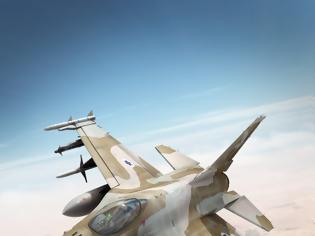2013-04-10 01:02:25

IAF source: Air force undergoing 'revolution'
Senior source tells 'Post' the IAF is in the middle of technological revolution that is creating a digital network in the skies.
The Israel Air Force is in the middle of a technological revolution that is creating a digital network in the skies, a senior IAF source told The Jerusalem Post on Monday.
As the Middle East continues to be afflicted by instability, radical terrorist organizations grow on Israel’s borders and Iran moves forward in its nuclear program, these new technologies could prove decisive to the outcome of future developments.
In the past, IAF aircraft dropped munitions on targets and returned to their bases, relying on radio communications and traditional sensors. Today, however, the jets and helicopters exchange data with a host of sources, from other aircraft flying with them, to ground forces, the Navy and intelligence services, and all in real time.
“We can communicate directly with other platforms... This acts as a force multiplier,” the source said.
“Plane A can tell Plane B what it is seeing in flight, and report all of this back [to IAF headquarters or airbases],” he added.
“It’s like a pack of leopards on a hunt. They work together in a network, not as individuals.”
Israel relies on the IAF as its primary response force to national security threats.
“The strategic challenges facing Israel are enormous, and continue to form the most complex obstacle for Israel,” the source said. Due to its ability to operate anywhere, as well as its accuracy, versatility and firepower, the IAF remains the best-suited force to respond, he added.
The trend toward networkcentric warfare is being driven by the air force’s Information Communications Technology branch. This shift is also the main reason that Israel chose the F35i to become its next fighter jet.
“The F35i was chosen not because it is the fastest or because it can carry the most munitions, but because of its network capabilities,” the source explained.
“All of the information is available to it. It knows what threatens it, its current situation, and the status of fellow aircraft. It is a network entity,” he added.
But the Air Force hasn’t been waiting for the F-35i’s arrival to construct its own network. Rather, it has spent the last decade installing these technologies on current aircraft, meaning that today, combat helicopters and squadrons of F-15s and F-16s are integrated with the rest of the military.
As a result, the source said, so much information is available that it is a challenge not to overload the pilot. “He should get the information he needs, when he needs it, where he needs it,” the source said.
Computers on-board the aircraft, together with ground stations, process the information for the pilot during the sorties.
“The network adds a layer… we’re sending and receiving data because the operational need dictates this,” the source said.
http://www.jpost.com/Defense/IAF-source-Air-force-undergoing-network-revolution-309141
Senior source tells 'Post' the IAF is in the middle of technological revolution that is creating a digital network in the skies.
The Israel Air Force is in the middle of a technological revolution that is creating a digital network in the skies, a senior IAF source told The Jerusalem Post on Monday.
As the Middle East continues to be afflicted by instability, radical terrorist organizations grow on Israel’s borders and Iran moves forward in its nuclear program, these new technologies could prove decisive to the outcome of future developments.
In the past, IAF aircraft dropped munitions on targets and returned to their bases, relying on radio communications and traditional sensors. Today, however, the jets and helicopters exchange data with a host of sources, from other aircraft flying with them, to ground forces, the Navy and intelligence services, and all in real time.
“We can communicate directly with other platforms... This acts as a force multiplier,” the source said.
“Plane A can tell Plane B what it is seeing in flight, and report all of this back [to IAF headquarters or airbases],” he added.
“It’s like a pack of leopards on a hunt. They work together in a network, not as individuals.”
Israel relies on the IAF as its primary response force to national security threats.
“The strategic challenges facing Israel are enormous, and continue to form the most complex obstacle for Israel,” the source said. Due to its ability to operate anywhere, as well as its accuracy, versatility and firepower, the IAF remains the best-suited force to respond, he added.
The trend toward networkcentric warfare is being driven by the air force’s Information Communications Technology branch. This shift is also the main reason that Israel chose the F35i to become its next fighter jet.
“The F35i was chosen not because it is the fastest or because it can carry the most munitions, but because of its network capabilities,” the source explained.
“All of the information is available to it. It knows what threatens it, its current situation, and the status of fellow aircraft. It is a network entity,” he added.
But the Air Force hasn’t been waiting for the F-35i’s arrival to construct its own network. Rather, it has spent the last decade installing these technologies on current aircraft, meaning that today, combat helicopters and squadrons of F-15s and F-16s are integrated with the rest of the military.
As a result, the source said, so much information is available that it is a challenge not to overload the pilot. “He should get the information he needs, when he needs it, where he needs it,” the source said.
Computers on-board the aircraft, together with ground stations, process the information for the pilot during the sorties.
“The network adds a layer… we’re sending and receiving data because the operational need dictates this,” the source said.
http://www.jpost.com/Defense/IAF-source-Air-force-undergoing-network-revolution-309141
ΜΟΙΡΑΣΤΕΙΤΕ
ΔΕΙΤΕ ΑΚΟΜΑ
ΣΧΟΛΙΑΣΤΕ














